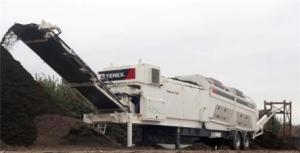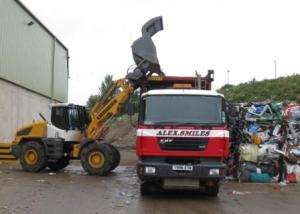IDE President Terry Quarmby takes a timely look at the definition of waste.
 The 2009 series of Institute of Demolition Engineers Seminars and Road Shows touched upon the subject of waste. I was reminded that the UK Construction Industry produces around 100 million tonnes of Construction, Demolition and Excavation waste per annum and that only 50% of this material is regularly recycled with the remainder going into landfill, spread on exempt sites or used as quarry fill. The UK Governments ‘Waste Strategy for England 2007’ sets out critical objectives for waste reduction and resource efficiency and these include to:
The 2009 series of Institute of Demolition Engineers Seminars and Road Shows touched upon the subject of waste. I was reminded that the UK Construction Industry produces around 100 million tonnes of Construction, Demolition and Excavation waste per annum and that only 50% of this material is regularly recycled with the remainder going into landfill, spread on exempt sites or used as quarry fill. The UK Governments ‘Waste Strategy for England 2007’ sets out critical objectives for waste reduction and resource efficiency and these include to:
• provide the drivers for the sector to improve its economic efficiency by creating less waste from design to demolition
• treat waste as a resource, re-using and recycling more and asking contractors for greater use of recovered material
• improve the economics of the re-use and recycling sector by increasing demand and securing investment in the treatment of waste
These objectives are very definitely what is needed and will serve to stimulate action amongst the hundreds of private and public authorities and organisations that manage or provide enforcement, licensing and disposal of waste products and materials.
It is regrettable, that the demolition sector, could have told anyone that cared to listen that this is what was needed 20 years ago. It is, therefore, both disappointing and offensive that the demolition industry is categorised and branded with construction when it comes to the reporting of waste management and recycling.
However, it could just as easily be said that the demolition sector had only itself to blame by an absence or desire to sit at the table when such subjects were being debated. The outcome of which one may suspect is a preordained move sanctioned by the UK government to massage the pitiful recycling figures reached by constructors and builders alike, by grouping in a sector that has consistently achieved high returns in such as recycling, reclamation and re-use. No doubt demolition contractors would desire to inform statisticians, environmentalists, central and local governments etc that the one thing they abhor more than anything else is paying to cart away waste.
But what is waste? That same question has been asked many times and those who have researched the answer will be mindful of UK Case Law of 2003 when the EA v Mayer Parry case came to court. The judge in this case determined that anything that was discarded, intended to be discarded, required to be discarded or had fallen out of the normal chain of utility was classed as a waste, and that it only ceased to be a waste when a process of recovery was complete. There is of course a disparity when deciding at which point the recovery is complete.
This year another ground breaking case arrived in court that did not go the way of the EA. In March 2009 the EA v Inglenorth case hinged on whether demolition materials owned by Inglenorth’s client was waste. Mr Evans, who owned two garden centres demolished a greenhouse on one site with the intention of moving the materials to the other in order to improve the car parking. At no point did he have an intention to discard the material, which was not toxic, hazardous to health or a danger to the public, but instead he wanted to reuse it. Mr Evans employed Inglenorth, the defendant, to move the materials. The EA prosecuted the defendant under section 33(1)(a) failure to hold a waste management license and section 34(1)(a) of the Environmental Protection Act 1990 (EPA) with a failure to take reasonable measures to prevent a third party from breaching the EPA. The magistrates found not guilty on the basis that the material was not waste as defined under the Waste Framework Directive (WFD) and section 75(2) EPA. The EA quite naturally appealed to the High Court. The main findings of the court were as follows;
• ‘Waste’ cannot be interpreted restrictively and discard must be interpreted in light of the aims of the WFD (which include protection of human health and the environment and includes substances discarded by their owners, even if they are capable of economic use or have a commercial value).
• In general (but depending on the facts) hardcore materials which are going to be used next week for current building operations are not being stored.
• There was a distinction between depositing the material for storage pending proposed reuse and depositing it for use more or less straight away.
• Immediate use cannot be taken literally. As the defendants were clearly not going to reuse the material, the question of immediate use could only be judged based on the intention of the owner of the waste. The defendant dropped out of the picture once it had delivered the waste and Mr Evans was clearly not going to use it within five minutes of its delivery.
• On the basis that Mr Evans had a clear intention to use the material and had no intention of discarding it, the material was not waste under the EPA or WFD.
The high Court dismissed the appeal by the EA and refused permission to appeal to the House of Lords on a point of law.
So the question is What Is and Is Not Waste? Do you work along the lines that if a building/structure or product has been discarded it is waste or are we to determine that it is the intention to recycle everything. Some materials, such as many hazardous substances or products cannot effectively be recycled. However, they can be handled and disposed of by others who do hold a waste management license.
In addition to the two examples of case law given there are a number of others concerning UK and European organisations that have also helped to determine the meaning of waste and in particular waste products. However, case law is less than helpful to the demolition industry sector as in general it is vague, particularly for ‘end of waste’ products. The definition of waste has not changed despite the revision to the Waste Framework Directive of 2008 in that the phrase ‘Discard’ is the benchmark. Putting this into perspective and playing Devil’s advocate, a factory, house, office block, shed, bridge or any structure that falls out of the normal chain of utility, in other words is not needed anymore and is discarded, could be classed as waste according to the WFD. Should the EA wish to challenge the exemptions that demolition currently enjoys, in the waiving of some of the waste licensing criteria, the industry may find that a demolition company inadvertently sets new case law following a prosecution. There is one at least one positive key objective coming from the new directive and that is to;
• Encourage recovery which leads to genuine ‘secondary’ product, from waste; and
• Make sure that in doing so there is not, as a result, adverse impact on human health or the environment.
These are objectives that are easily achieved in the majority of the materials and products that the industry handles during the demolition process. The problem though lays in the use of the word ‘waste’ for all demolition materials.
It is possible to have some sympathy for the government and the EA in particular, in that circumstances have largely dictated the route taken regarding waste and the disposal of it. If you revisit the beginning of this paper and the fact that approximately 50% of all C, D & E waste ends up largely in landfill, it is little wonder that statutory regulation wields a large axe on those who do not embrace a positive waste strategy or seek to recycle, reclaim or re-use. Up until very recently it was common practice for builders, constructors and refurbishment contractors, in particular, to deposit all their waste materials into one container and to dispatch this to landfill.
It is also possible to argue that such practices are still fairly common given the amount arriving at our landfill sites. The questions that I would like to see posed to government are these;
1. When did you see a demolition contractor putting hardcore into the same skip as paper, timber and plastics? The answer is never.
2. How many times do you see a demolition contractor mixing clean timber with dirty or contaminated timber? The answer is rarely.
3. When have you ever heard of a demolition contractor sending scrap metals to landfill? The answer is never, unless it’s got asbestos stuck to it.
One may argue that the time has arrived for government, the EA, environmentalists, academics and the sustainability lobby to give the demolition sector the recognition it truly deserves and to assist them to carry on what is a highly efficient, effective and much needed service to all industries. No doubt there is little expectation that legislation will be swept aside or that licensing of any activity becomes unnecessary.
However, it does require a relaxation of some of the licensing criteria and certainly a review of the Acts, Regulations, Codes of Practice and Guidance to ensure that secondary products and materials are given a similar status to new.


 The 2009 series of
The 2009 series of  A Terex Finlay 790 Trommel has been supplied by Finlay Plant North West – part of the Finlay Group of companies – to compost producers WGR, based in Nantwich, Cheshire.
A Terex Finlay 790 Trommel has been supplied by Finlay Plant North West – part of the Finlay Group of companies – to compost producers WGR, based in Nantwich, Cheshire. Powerscreen has launched its new Warrior 800 as part of its new product development programme, adding the unit to its range of heavy duty screening machines.
Powerscreen has launched its new Warrior 800 as part of its new product development programme, adding the unit to its range of heavy duty screening machines. Alex Smiles Limited has continued its quarter century allegiance to Liebherr-Great Britain Limited with the purchase of a specialist L 5382plus1 PK-HL high-lift wheeled loading shovel waste handler, which is now hard at work at the Alex Smiles Limited waste transfer facilities in Sunderland.
Alex Smiles Limited has continued its quarter century allegiance to Liebherr-Great Britain Limited with the purchase of a specialist L 5382plus1 PK-HL high-lift wheeled loading shovel waste handler, which is now hard at work at the Alex Smiles Limited waste transfer facilities in Sunderland.